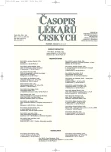Early repolarisation syndrome and idiopathic ventricular fibrillation
Authors:
Jaroslav Šimon; Petr Neužil
Authors place of work:
Kardiologické oddělení Komplexního kardiovaskulárního centra Nemocnice Na Homolce, Praha
Published in the journal:
Čas. Lék. čes. 2011; 150: 236-239
Category:
Přehledový článek
Summary
Syndrome of early repolarisation is a relatively not common electrocardiographic pattern with typically elevated J wave in most of the cases in lead II, III, aVF and V3–V6. There is increasing evidence that the early repolarisation might be associated with increased risk of sudden cardiac death in otherwise healthy individuals. Early repolarisation ECG pattern in inferolateral leads is associated with sudden death in younger otherwise healthy individuals. Identification of this risky group based on pure ECG criteria is still challenging but it must be considered in individuals with family history of sudden cardiac death or cardiac arrest.
Key words:
early repolarisation-idiopathic ventricular fibrillation-sudden cardiac death.
Zdroje
1. Haissaguerre M, Derval N, Sacher F, et al. Sudden Cardiac Arrest Associated with Early Repolarization. N Engl J Med 2008; 350: 2016–2023.
2. Gussak I, Antzelevitch C. Early repolarization syndrome: clinical characteristics and possible cellular and ionic mechanisms. J Electrocardiol 2000; 33: 299–309.
3. YAN GX, Antzelewitch C. Cellular basis for the electrocardographic J wave. Circulation 1990, 93: 372–379.
4. Shinohara T. Characterization of J wave in a patient with idiopathic ventricular fibrillation. Heart rhythm 2006; 3: 1082–1084.
5. Hassaguerre M, Sacher F, Nogami A, et al. Characteristics of Recurrent Ventricular Fibrillation Associated With Inferolateral Early Repolarization. JACC 2009; 7: 612–619.
6. Corrado D, Pelliccia A, Heidbuchle H, et al. Recommendations for interpretation of 12-lead electrocardiogram in the atlete. EHJ 2010; 31: 243–259.
7. Tikkanen JT, Anttonen O, Juntilla MJ, et al. Long-Term Outcome Associated with Early Repolarization on Electrocardiography. N Engl J Med 2009; 361: 2529–2537.
8. Viskin S. Idiopathic Ventricular Fibrillation „Le Syndrome d’Haissaguerre“ and the fear of J waves JACC 2009; 7: 620–622.
9. Chen Q, Kirsch EG,Zhang D, et al. Genetic basis and molecular mechanism for idiopathic ventricular fibrillation. Nature 1998; 392: 293–296.
10. Nam BG, Ho-Ko K, Kim J, et al. Mode of onset of ventricular fibrillation in patients with early repolarization pattern vs. Brugada syndrome. EHJ 2010; 31: 330–339.
11. Wang Y, Chen J, Joyner WR,et al.Remodeling of Early-Phase Repolarization. Circulation 2006; 113: 1849–1856.
12. Riera AR, Uchida AH, Schapachnik E, et al. Early repolarization variant: epidemiological aspects,mechanism, and differential diagnosis. Cardiol J 2008; 15: 203.
13. Potse M, Coronel R, Opthof T, et al. The positive T wave. Anadolu Kardiyol Derg. 2007; 1: 164–167.
14. James AF, Choisy SC, Hancox JC. Recent advances in understanding sex differences in cardiac repolarization. Prog Biophys Mol Biol 2007; 94: 265–319.
15. Haissaguerre M, Chatel S, Sacher F, et al. Ventricular fibrillation with prominent early repolarization associated with a rare variant of KCNJ8/KATP channel. J Cardiovasc Electrophysiol 2009; 20: 93–98.
16. Alders M, Koopmann TT, Christians I, et al. Haplotype-sharing analysis implicates chromosome 7q36 harboring DPPS in familial idiopathic ventricular fibrillation. Am J Hum Genet 2009; 84: 468–476.
17. Shu J, Zhu T, Yang L, et al. ST-segment elevation in the early repolarization syndrome, idiopathic ventricular fibrillation, and the Brugada syndrome: cellular and clinical linkage. J Electrocardiol 2005; 38: 26–32.
18. Di Grande A, Tabita V, Lizzio MM, et al. Early repolarization syndrome and Brugada syndrome: is there any linkage. Eur J Intern Med 2008; 19: 236–240.
19. Yan GX, Antzelevitch C. Cellular basis for the Brugada syndrome and the other mechanism of arrhythmogenesis associated with ST-segment elevation. Circulation 1999; 15: 1660–1666.
Štítky
Adiktologie Alergologie a imunologie Angiologie Audiologie a foniatrie Biochemie Dermatologie Dětská gastroenterologie Dětská chirurgie Dětská kardiologie Dětská neurologie Dětská otorinolaryngologie Dětská psychiatrie Dětská revmatologie Diabetologie Farmacie Chirurgie cévní Algeziologie Dentální hygienistkaČlánek vyšel v časopise
Časopis lékařů českých

- Tirzepatid – nová éra v léčbě nadváhy a obezity
- Přerušovaný půst může mít významná zdravotní rizika
- Ukažte mi, jak kašlete, a já vám řeknu, co vám je
- Metamizol jako analgetikum první volby: kdy, pro koho, jak a proč?
- Obezita je nemoc, kterou je třeba diagnostikovat a léčit
Nejčtenější v tomto čísle
- Syndrom časné repolarizace a idiopatická fibrilace komor
- Temporální epilepsie dospělých a možnosti neurochirurgické léčby: úloha magnetické rezonance
- Nekonvulzivní status epilepticus
- Využití vydechovaného oxidu dusnatého v diagnostice astmatu
